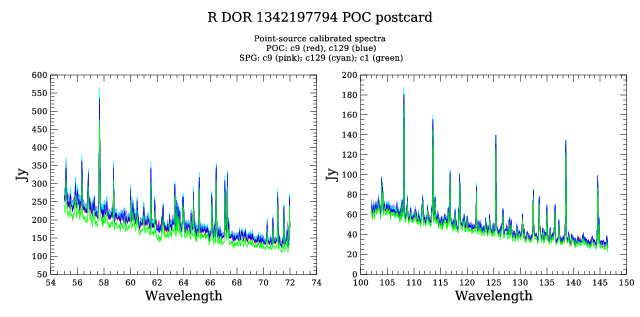PACS Spectrometer: Pointing Offset Corrected Spectra

INTRODUCTION
The standard (SPG) products provided for PACS spectroscopy observations in the
Herschel Science Archive (HSA) include tables of point-source calibrated spectra. These are provided only for pointed observations, with the assumption that point sources would have been observed primarily in this mode. For observations of point sources that are centred in the FoV and are not contaminated by another source, these tables are the science product to take.
For sources that are not well centred in the FoV, however, this product is not necessarily the best to use, as it will be an underestimate of the flux levels. In the “PACS Pipelines” menu of the Herschel software (HIPE), there is an alternative interactive pipeline that can potentially provide better spectra of point sources than the SPG pipeline can produce. This is the “Pointing Offset Correction” (POC) pipeline. The conditions under which better spectra can be produced, and what “better” means, are explained in the
POC HPDP release note. The POC pipeline is a full data-reduction pipeline and is similar to the SPG pipeline for the same observing mode, but it has additional pointing-offset correction tasks. These attempt to identify the offset of a point source from the centre of the FoV and to correct the flux of the cube accordingly. The end result of the pipeline is a point-source calibrated spectrum. Generally-speaking, this pipeline is suited to brighter sources, and produces better spectra for point sources that are offset from the central spaxel, but still located within the central 3x3 spaxels, of a rebinned cube.
SCOPE AND CONTENT OF THE DELIVERY
This POC pipeline has been run on all pointed observations of chop-nod mode (the pipeline does not work on unchopped observations). The result of the pipeline for each observation is a point-source calibrated spectrum for each wavelength range, of each camera, and this is provided in the form of the same point-source spectrum table provided in the SPG products.
While the pipeline script was run on all pointed observations, it did not succeed on all - failure was usually due to lack of SNR or a sufficient pointedness of the source. Only the successfully-processed obsids are provided in this
POC HPDP. Only the range 50-190 µm is provided.
Note that no determination has been made whether the target of the observation is a point-source or not: the pipeline was run regardless. Hence its results are only valid for true point sources, and that determination must be made by the user of these products.
